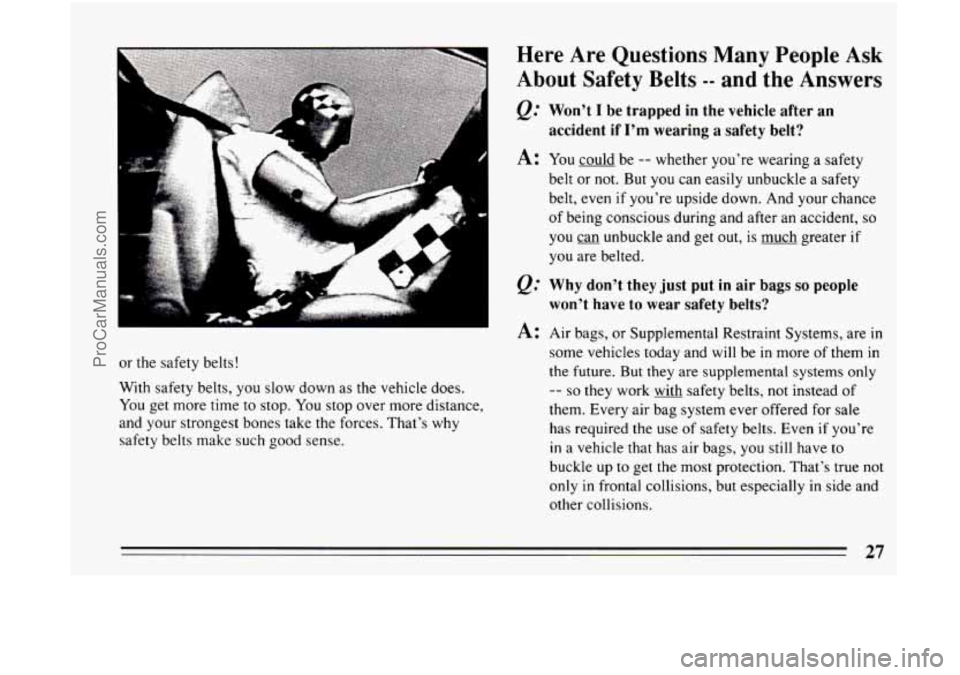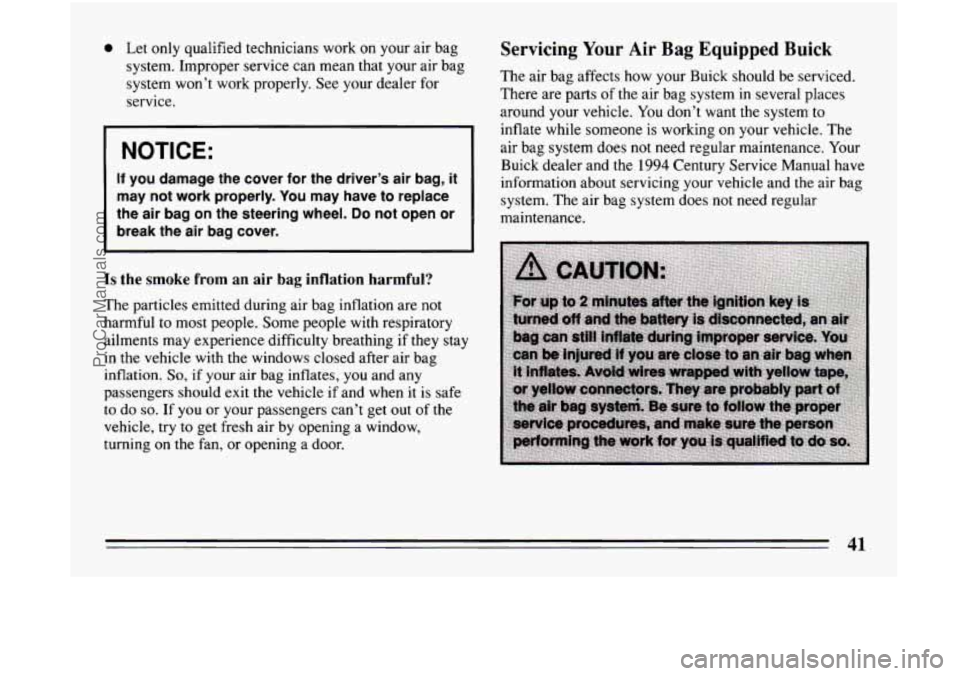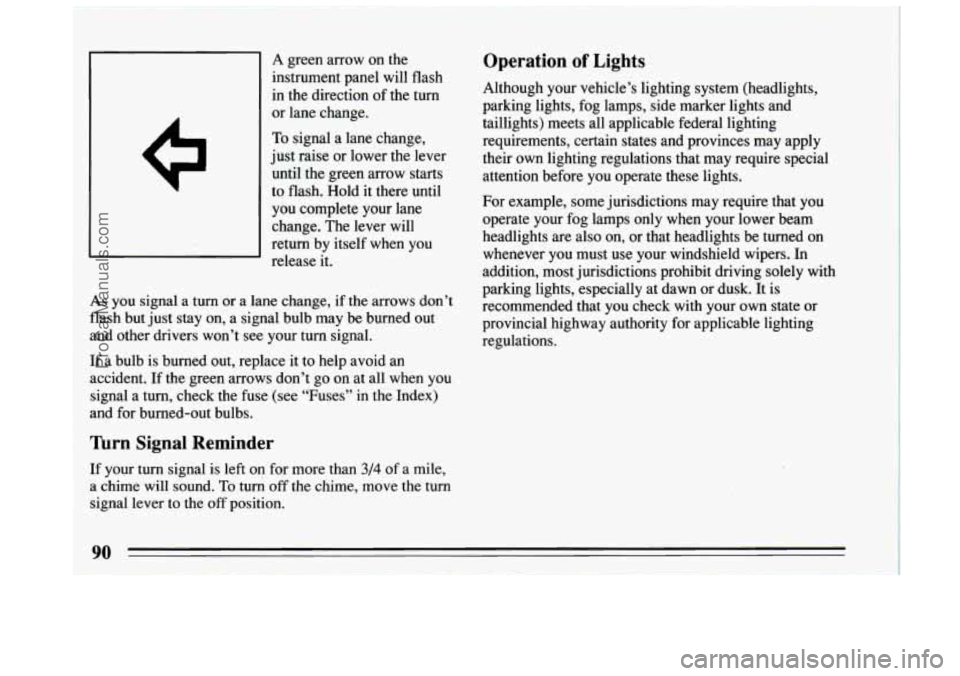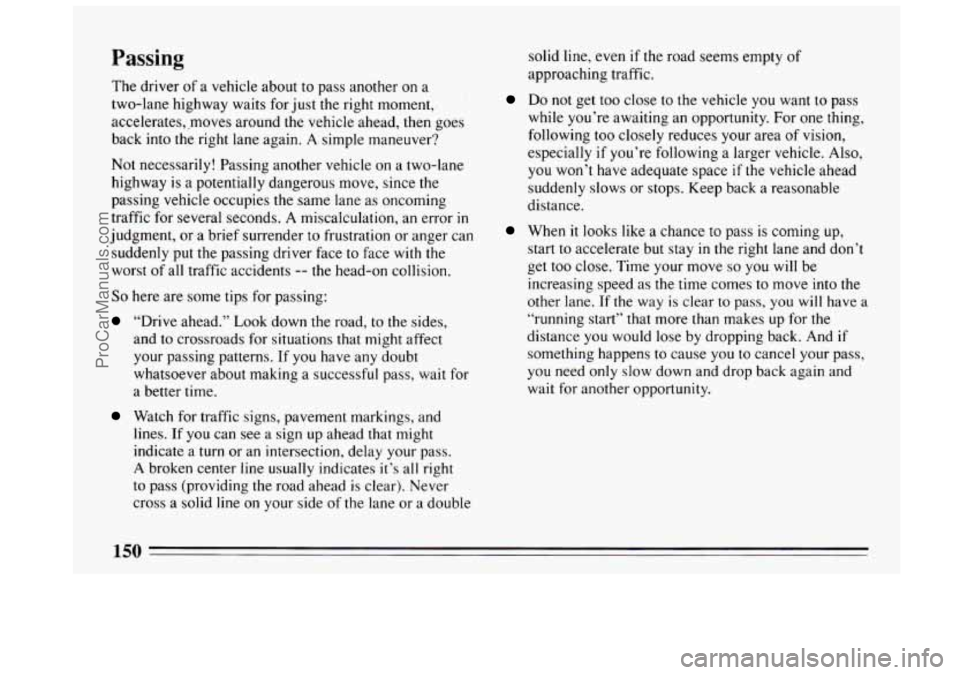ESP BUICK CENTURY 1994 Owners Manual
[x] Cancel search | Manufacturer: BUICK, Model Year: 1994, Model line: CENTURY, Model: BUICK CENTURY 1994Pages: 308, PDF Size: 16.3 MB
Page 6 of 308

Walter Marr and Thomas Buick
Buick’s chief engineer, Walter L. Marr (left), and
Thomas D. Buick, son of founder David Dunbar Buick,
drove the first Flint Buick in a successful Flint-Detroit
round trip in July 1904.
David Buick was building gasoline engines by 1899,
and Marr, his engineer, apparently built the first auto to
be called a Buick in 1900. However, Buick traditionally
dates its beginnings to 1903. That was the year the
company was reorganized, refinanced and moved from
Detroit to Flint. Buick has always been a product
innovator. Buick engineers developed the “valve-in-head”
engine, a light, powerful and reliable
engine which would eventually influence the entire
automotive industry.
William
C. Durant was instrumental in promoting
Buicks across
the country using his Durant-Dort
Carriage
Co. outlets and salespeople as the nucleus of a
giant distribution system.
He knew the Buick as a
“self-seller”.
If automobiles could be this good, he
thought, maybe
it was time to switch from the horse and
buggy business
to automobiles.
William C. (Billy) Durant
At the 1905, New York
Auto Show, Durant took orders
for 1,000 Buicks
before the company had
built
40. On Buick’s
success, Durant created a
holding company,
September 16, 1908. He
called it General Motors.
4
ProCarManuals.com
Page 29 of 308

B
or the safety belts!
With safety belts,
you slow down as the vehicle does.
You get more time to stop. You stop over more distance,
and your strongest bones take the forces. That’s why
safety belts make such good sense.
Here Are Questions Many People Ask
About Safety Belts -- and the Answers
@ Won’t I be trapped in the vehicle after an
accident if
I’m wearing a safety belt?
A: You could be -- whether you’re wearing a safety
belt or
not. But you can easily unbuckle a safety
belt, even if you’re upside down. And your chance
of being conscious during and after an accident,
so
you can unbuckle and get out, is much greater if
you are belted.
Q: Why don’t they just put in air bags so people
won’t have to wear safety belts?
A: Air bags, or Supplemental Restraint Systems, are in
some vehicles today and will be in more of them in
the future. But they are supplemental systems only
-- so they work with safety belts, not instead of
them. Every air bag system ever offered for sale
has required the use of safety belts. Even
if you’re
in a vehicle that has air bags, you still have to
buckle up to get the most protection. That’s true not
only in frontal collisions, but especially in side and
other collisions.
27
ProCarManuals.com
Page 43 of 308

0 Let only qualified technicians work on your air bag
system. Improper service can mean that your air bag
system won’t work properly. See your dealer for
service.
NOTICE:
If you damage the cover for the driver’s air bag, it
may not work properly. You may have to replace
the air bag on the steering wheel.
Do not open or
break the air bag cover.
Is the smoke from an air bag inflation harmful?
The particles emitted during air bag inflation are not
harmful to most people. Some people with respiratory
ailments may experience difficulty breathing if they stay
in the vehicle with the windows closed after air bag
inflation.
So, if your air bag inflates, you and any
passengers should exit the vehicle if and when it is safe
to
do so. If you or your passengers can’t get out of the
vehicle, try
to get fresh air by opening a window,
turning on the fan, or opening a door.
Servicing Your Air Bag Equipped Buick
The air bag affects how your Buick should be serviced.
There are parts
of the air bag system in several places
around your vehicle. You don’t want the system to
inflate while someone is working on your vehicle. The
air bag system does not need regular maintenance. Your
Buick dealer and the
1994 Century Service Manual have
information about servicing your vehicle and the air bag
system. The air bag system does not need regular
maintenance.
41
ProCarManuals.com
Page 76 of 308

Theft
Vehicle theft is big business, especially in some cities. Although your Buick has a number of theft deterrent
features, we know that nothing we put on it can make
it
impossible to steal. However, there are ways you can help.
Key in the Ignition
If you walk away from your vehicle with the keys
inside, it’s an easy target for joy riders or professional
thieves
-- so don’t do it.
When you park your Buick and open the driver’s door,
you’ll hear a chime reminding you to remove your key
from the ignition and take it
with you. Always do this.
Your steering wheel
will be locked, and so will your
ignition and transaxle. And remember to lock the doors.
Parking at Night
Park in a lighted spot, close all windows and lock your
vehicle. Remember to keep your valuables out
of sight.
Put them
in a storage area, or take them with you.
Parking Lots
If you park in a lot where someone will be watching
your vehicle, it’s best to lock
it up and take your keys. But what
if
you have to leave your ignition key? What if
you have to leave something valuable in your vehicle?
0 Put your valuables in a storage area, like your trunk
or glove box, or rear storage area in the wagon.
0 Lock the glove box.
0 Lock all the doors except the driver’s.
0 Then take the door key with you.
New Vehicle “Break-In”
I NOTICE:
Your modern Buick doesn’t need an elaborate
“break-in.” But
it will perform better in the long
run if you follow these guidelines:
Don’t drive at any one speed -- fast or slow
-- for the first 500 miles (804 km). Don’t
make full-throttle starts.
0 Avoid making hard stops for the first 200
miles (322 km) or so. During this time your
new brake linings aren’t yet broken
in. Hard
stops with new linings can mean premature
wear and earlier replacement. Follow this
“breaking-in” guideline every time you get
new brake linings.
74
ProCarManuals.com
Page 92 of 308

I I A green arrow on the
instrument panel will flash
in the direction of the turn
or lane change.
To signal a lane change,
just raise
or lower the lever
until the green arrow starts
to flash. Hold
it there until
you complete your lane
change. The lever will
return by itself when you
release it.
As you signal a turn or a lane change, if the arrows don’t
flash but just stay on, a signal bulb may be burned out
and other drivers won’t see your turn signal.
If a bulb is burned out, replace
it to help avoid an
accident. If the green arrows don’t go on at all when you
signal a turn, check the fuse (see “Fuses” in the Index)
and for burned-out bulbs.
nrn Signal Reminder
If your turn signal is left on for more than 3/4 of a mile,
a chime will sound.
To turn off the chime, move the turn
signal lever
to the off position.
Operation of Lights
Although your vehicle’s lighting system (headlights,
parking lights, fog lamps, side marker lights and
taillights) meets all applicable federal lighting
requirements, certain states and provinces may apply
their own lighting regulations that may require special
attention before you operate these lights.
For example, some jurisdictions may require that you
operate your fog lamps only when your lower beam
headlights are also on, or that headlights be turned on
whenever you must use your windshield wipers. In
addition, most jurisdictions prohibit driving solely with
parking lights, especially at dawn
or dusk. It is
recommended that you check with your own state or
provincial highway authority for applicable lighting
regulations.
90
ProCarManuals.com
Page 127 of 308

Audio Systems
Your Delco@ audio system has been designed to operate
easily and give years
of listening pleasure. But you will
get the most enjoyment out
of it if you acquaint yourself
with it first. Find out what your Delco@ system can do
and how to operate all its controls, to be sure you're
getting the most out of the advanced engineering that
went into it.
AM Stereo
FM Stereo
FM stereo will give you the best sound. But FM signals
will reach only about
10 to 40 miles (16 to 65 km). Tall
buildings or hills can interfere with
FM signals, causing
the sound to come and
go.
AM
The range for most AM stations is greater than for FM,
especially at night. The longer range, however, can
cause stations to interfere with each other. AM can also
pick up noise from things like storms and power lines.
Try reducing the treble to lower this noise. Your
Delco@ system may be able to receive C-Quam@
stereo broadcasts. Many AM stations around the country
use C-Quam@
to produce stereo, though some do not.
(C-Quam@ is a registered trademark of Motorola, Inc.)
If your Delco' system can get C-Quam@ signals, your
stereo indicator light will come on when you are
receiving
it.
Be aware that hearing damage from loud noise is almost
undetectable
until it is too late. Your hearing can adapt
to higher volumes of sound. Sound that seems normal
can be loud and harmful to your hearing. Take
precautions by adjusting the volume control
on your
radio to a safe sound level before your hearing adapts
to it.
125
ProCarManuals.com
Page 145 of 308

“I‘ll be careful” isn’t the right answer. What if there’s an
emergency, a need to take sudden action, as when a
child darts into the street?
A person with a higher BAC
might not be able to react quickly enough to avoid the
collision.
There’s something else about drinking and driving that
many people don’t know. Medical research shows that
alcohol
in a person’s system can make crash injuries
worse. That’s especially true for brain, spinal cord and
heart injuries. That means that
if anyone who has been
drinking
-- driver or passenger -- is in a crash, the
chance of being killed or permanently disabled
is higher
than
if that person had not been drinking. And we’ve
already seen that the chance
of a crash itself is higher for
drinking drivers.
A CAUTION:
143
ProCarManuals.com
Page 152 of 308

The driver of a vehicle about to pass another on a
two-lane highway waits for just
the right moment,
accelerates, ,moves around the vehicle ahead, then goes
back into the right lane again. A simple maneuver?
Not necessarily! Passing another vehicle on a two-lane
highway
is a potentially dangerous move, since the
passing vehicle occupies the same lane as oncoming
traffic for several seconds.
A miscalculation, an error in
judgment, or a brief surrender to frustration or anger can
suddenly put
the passing driver face to face with the
worst of all traffic accidents
-- the head-on collision.
So here are some tips for passing:
“Drive ahead.’’ Look down the road, to the sides,
and to crossroads for situations that might affect
your passing patterns. If you have any doubt
whatsoever about making a successful pass, wait for
a better time.
Watch for traffic signs, pavement markings, and
lines. If you can see a sign up ahead that might
indicate a turn or an intersection, delay
your pass.
A broken center line usually indicates it’s all right
to pass (providing the road ahead is clear). Never
cross a solid line on your side of the lane or a double solid line, even
if the road
seems empty of
approaching traffic.
Do not get too close to the vehicle you want to pass
while you’re awaiting an opportunity. For one thing,
following too closely reduces your area of vision,
especially
if you’re following a larger vehicle. Also,
you won’t have adequate space if the vehicle ahead
suddenly slows or stops. Keep back a reasonable
distance.
When it looks like a chance to pass is coming up,
start to accelerate but stay in
the right lane and don’t
get
too close. Time your move so you will be
increasing speed as the time comes to move into
the
other lane. If the way is clear to pass, you will have a
“running start” that more than makes up for the
distance you would lose by dropping back. And
if
something happens to cause you to cancel your pass,
you need only
slow down and drop back again and
wait
for another opportunity.
150
ProCarManuals.com
Page 153 of 308

e If other cars are lined up to pass a slow vehicle, wait
your turn. But take care that someone isn’t trying to
pass you as you pull
out to pass the slow vehicle.
Remember to glance over your shoulder and check
the blind spot.
e Check your mirrors, glance over your shoulder, and
start your left lane change signal before moving out
of the right lane to pass. When
you are far enough
ahead of the passed vehicle to see
its front in your
inside mirror, activate your right lane change signal
and move back into the right lane. (Remember that
your right outside mirror is convex. The vehicle you
just passed may seem to be farther away from you
than
it really is.)
two-lane roads. Reconsider before passing the next
vehicle.
Try not to pass more than one vehicle at a time on
e Don’t overtake a slowly moving vehicle too rapidly.
Even though the brake lights are
not flashing, it may
be slowing down or starting to
turn.
If you’re being passed, make it easy for the
following driver to get ahead of you. Perhaps you
can ease a
little to the right.
Loss of Control
Let’s review what driving experts say about what
happens when the three control systems (brakes, steering
and acceleration) don’t have enough friction where the
tires meet the road to do what the driver has asked.
In any emergency, don’t give
up. Keep trying to steer
and constantly seek an escape route or area
of less
danger.
Skidding
In a skid, a driver can lose control of the vehicle.
Defensive drivers avoid most skids by taking reasonable
care suited to existing conditions, and by not
“overdriving” those Conditions. But skids are always
possible.
The three types
of skids correspond to your Buick’s
three control systems. In the braking skid your wheels
aren’t rolling. In the steering
or cornering skid, too
much speed or steering
in a curve causes tires to slip and
lose cornering force. And in the acceleration skid too
much
throttle causes the driving wheels to spin.
A cornering skid and an acceleration skid are best
handled by easing your foot off the accelerator pedal.
151
ProCarManuals.com
Page 155 of 308

0
0
0
0
0
Adjust your inside rearview mirror to reduce the
glare from headlights behind you.
Since you can’t see as well, you may need to slow
down and keep more space between you and other
vehicles.
Slow down, especially on higher speed roads. Your
headlights can light up only
so much road ahead.
In remote areas, watch for animals.
If you’re tired,
pull off the road in a safe place and
rest.
Night Vision
No one can see as well at night as in the daytime. But as
we get older these differences increase. A 50-year-old
driver may require at least twice as much light
to see the
same thing at night as a 20-year-old.
What you
do in the daytime can also affect your night
vision. For example,
if you spend the day in bright
sunshine you are wise to wear sunglasses. Your eyes
will
have less trouble adjusting to night. But if you’re
driving, don’t wear sunglasses at night. They may cut
down on glare from headlights, but they also make a lot
of things invisible. You
can be temporarily blinded by approaching lights.
It can take a second or two, or
even several seconds, for
your eyes to readjust to the dark. When
you are faced
with severe glare (as from a driver who doesn’t lower
the high beams, or a vehicle with misaimed headlights),
slow down a little. Avoid staring directly into the
approaching lights.
Keep your windshield and all the glass on your vehicle
clean
-- inside and out. Glare at night is made much
worse by dirt
on the glass. Even the inside of the glass
can build up a film caused by dust. Dirty glass makes
lights dazzle and flash more than clean glass would,
making the pupils of your eyes contract repeatedly.
Remember that your headlights light up far less of a
roadway when
you are in a turn or curve. Keep your
eyes moving; that way, it’s easier to pick
out dimly
lighted objects. Just as your headlights should be
checked regularly
for proper aim, so should your eyes
be examined regularly. Some drivers suffer from night
blindness
-- the inability to see in dim light -- and
aren’t even aware
of it.
153
ProCarManuals.com